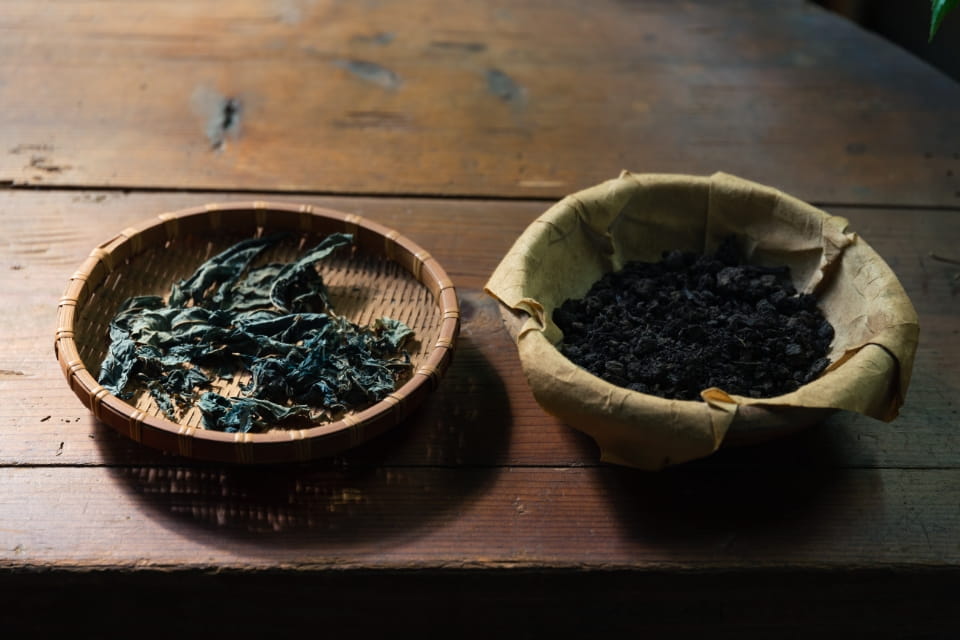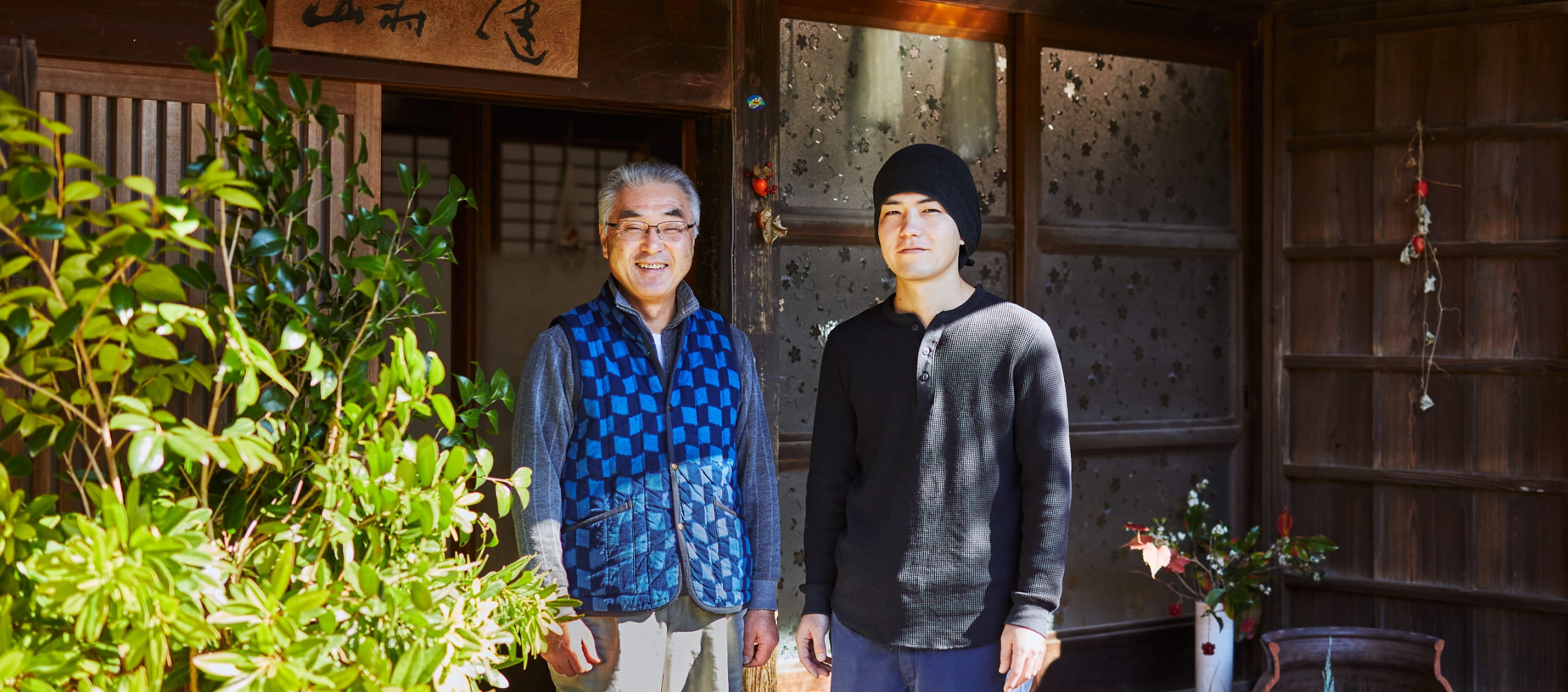






The Infinite Possibilities of Indigo
The fifth generation owner of Aizome Kasuri Kobo, Kensuke Yamamura, is in charge of indigo dyeing at the workshop. While honoring the methods inherited from his father, Takeshi, Kensuke builds upon his experiences to search for an indigo unique to the workshop. It is said that there are 48 shades of indigo blue in Japan, but Kensuke can dye indigo in 100 different colors.
The 100 Shades of Indigo of
Aizome Kasuri Kobo

The Colors of Chikugo
Used all over the world, indigo is said to be the oldest dye known to humans. Even amongst indigos, their colors and tints differ greatly by region. In the past, indigo cultivation flourished in the Chikugo region, home to Aizome Kasuri Kobo. While indigo cultivation is basically nonexistent in the region today, Aizome Kasuri Kobo continues to value the colors and tones unique to Chikugo.

Raw Materials
While a chemical dye called Indigo Pure is commonly used worldwide, Aizome Kasuri Kobo uses sukumo (dried and fermented indigo leaves) from Tokushima. Along with Tokushima’s Yoshino River, the Chikugo River is one of Japan’s “three most violent rivers.” Its frequent flooding brought fertile soil to the area, so indigo production once flourished in the region. Today, indigo is rarely grown in this area. But Aizome Kasuri Kobo continues to grow their own indigo not for use in kasuri making, but for deepening understanding of the raw material.

Water
Dyeing with natural dyes requires a lot of water, which is used when fermenting indigo, washing dyed yarn and cloth, and washing woven cloth to prevent shrinkage. For ages, the Chikugo area has been blessed with good water in abundant quantities, which has supported kasuri production. At Aizome Kasuri Kobo, beautiful indigo blue is created by using groundwater with low iron content that flows from the Mino Mountains. The groundwater is kept at a constant temperature in all seasons, making it easy for craftspeople to work with.

Fermentation
The dye contained within indigo does not dissolve in water as is, so it is fermented through the work of microorganisms to make the indigo ready for dyeing. This is why it is often said that indigo is “alive.” While reducing agents such as hydrosulfite are often used by indigo dyers, Aizome Kasuri Kobo continues to uphold a traditional method to promote fermentation. After burning sawtooth oak and extracting lye from its ashes and dissolving it in groundwater, the artisans add wheat bran and the ash of shells collected from the Ariake Sea to the indigo. In the winter, the workshop’s indigo vats are kept at a constant temperature by heating them over a fire fueled by the strained lees of local haze wax trees.

Dyeing
Brown indigo liquid turns blue when exposed to air, a process that seems nothing less than magic at work. Because of this oxidation process, soaking fabric in indigo for a long time does not make its color darker. Instead, when dyeing yarn or cloth, the process of soaking the material in indigo, wringing it, and letting it air dry is repeated over and over again. Aizome Kasuri Kobo uses a light colored indigo solution to dye fabric many times to create an indigo color that does not fade easily. When the dyeing is finished, it is almost impossible to tell the difference between fabric dyed with this method and that dyed with dark indigo solution. The unique feature of Aizome Kasuri Kobo’s work is that their indigo color becomes more and more vivid with use.

Kurume Kasuri
Kurume Kasuri is a plain weave cotton fabric that has been woven in the Chikugo region of southern Fukuoka Prefecture for about 200 years. Kasuri (also known as ikat) is the technique of creating patterns by tying yarn in some places before dyeing. The technique exists all over the world, in places such as Southeast Asia, Central and South America, and Central Asia. In the past, Hiroshima and Okayama’s Bingo Kasuri in Hiroshima and Okayama, Ehime’s Iyo Kasuri, and Fukuoka’s Kurume Kasuri were considered the three major kasuri production regions in Japan. However, after Bingo Kasuri production shifted to canvas and denim, and Iyo Kasuri production shifted to towels, Kurume Kasuri is the only remaining full-scale kasuri production region in Japan.

Aizome Kasuri Kobo’s Production Process
The Kurume Kasuri production process involves 30 steps over the course of three months. The following is a summary of the main steps.

01
Design
Takeshi Yamamura is in charge of creating designs. He re-interprets traditional patterns into geometric designs with a modern sensitivity, creating work that can be used easily within interior design.

02
Tying
The most characteristic process unique to Kurume Kasuri, craftspeople tie the yarn in places according to the design sheet. When the yarn is dyed, these areas remain their original color. At Aizome Kasuri Studio, Takeshi hand-ties each of the complex parts of the design which cannot be done by machine.

03
Dyeing
The process of repeatedly soaking the yarn in indigo and hitting it against the floor to allow the indigo to oxidize is hard work. Kensuke’s movements during the dyeing process are very deliberate. Despite his aggressive movements, there is hardly any indigo liquid that spills out across the workshop.

04
Weaving
Aizome Kasuri Kobo specializes in a type of kasuri where both the weft and weave are tied. Craftspeople take their time to weave one step at a time, carefully matching the warp and weft patterns along the way. In this way, the workshop is able to weave exquisite patterns that cannot be reproduced on power looms.

The Craftspeople

Kensuke Yamamura
Fifth Generation Owner, Aizome Kasuri Kobo
Head of Dyeing
While honoring the methods inherited from his father, Takeshi, Kensuke builds upon his experiences to create unique innovations. Since he was a child, Kensuke loved observing the river fish, insects, and other living things that surrounded him. Day after day, Kensuke conducts a taste test of the indigo to check it’s condition, making delicate adjustments as if having a dialogue with the dye. The question of the beauty of the Chikugo region and its indigo, and one’s place as a indigo dyer within it, Kensuke is facing this question each day through his craftmaking.

Takeshi Yamamura
Fourth Generation Owner, Aizome Kasuri Kobo
Head of Design, Tyeing, and Weaving
Member of the Important Intangible Cultural Property Holders Association
Member of the Japan Traditional Crafts Association
Takeshi taught himself the basics of indigo dyeing, and has been creating work with unique geometric patterns that employs indigo gradation while also developing sales channels. When I talk with Takeshi, the phrase “I do it because it’s fun” comes up frequently. He does not believe in making the same pattern over and over again, always trying new things, even if it is sometimes unprofitable. His enthusiasm for craftmaking comes through this adventurous spirit.

A Craftmaking Experience at Aizome Kasuri Kasuri Kobo
Make Your Very Own Indigo Art at Aizome Kasuri Kobo (2hrs)
First take an inside look at the workshop’s studio space and indigo fields before creating your own piece of art by dyeing cloth or Japanese washi paper with indigo. Through this hands-on experience, enjoy the color of rich indigo blue itself.

Craft Inn 手 [té] / indigo room
Craft Inn 手 [té] is an inn where you can experience a stay amongst Kyushu’s crafts. Each of the three rooms is themed with a different craft tradition. The indigo room is a window into the world of Aizome Kasuri Kobo, featuring a large wooden table boldly dyed by Kensuke Yamamura, Kurume Kasuri tapestries, cushions, and more.








